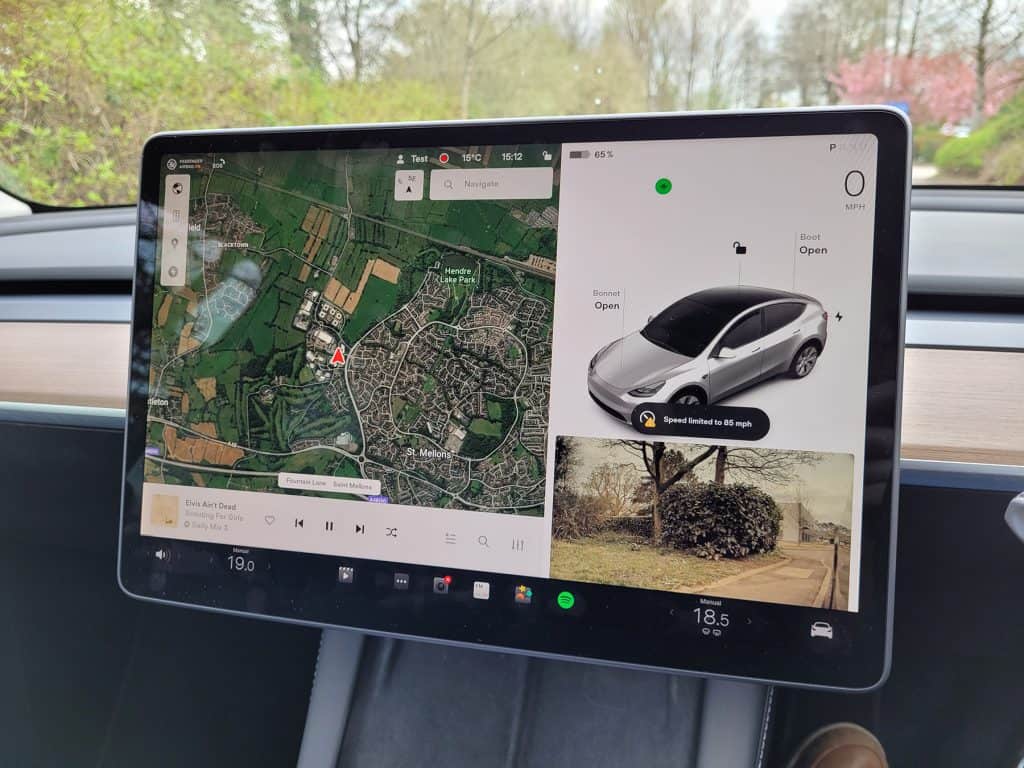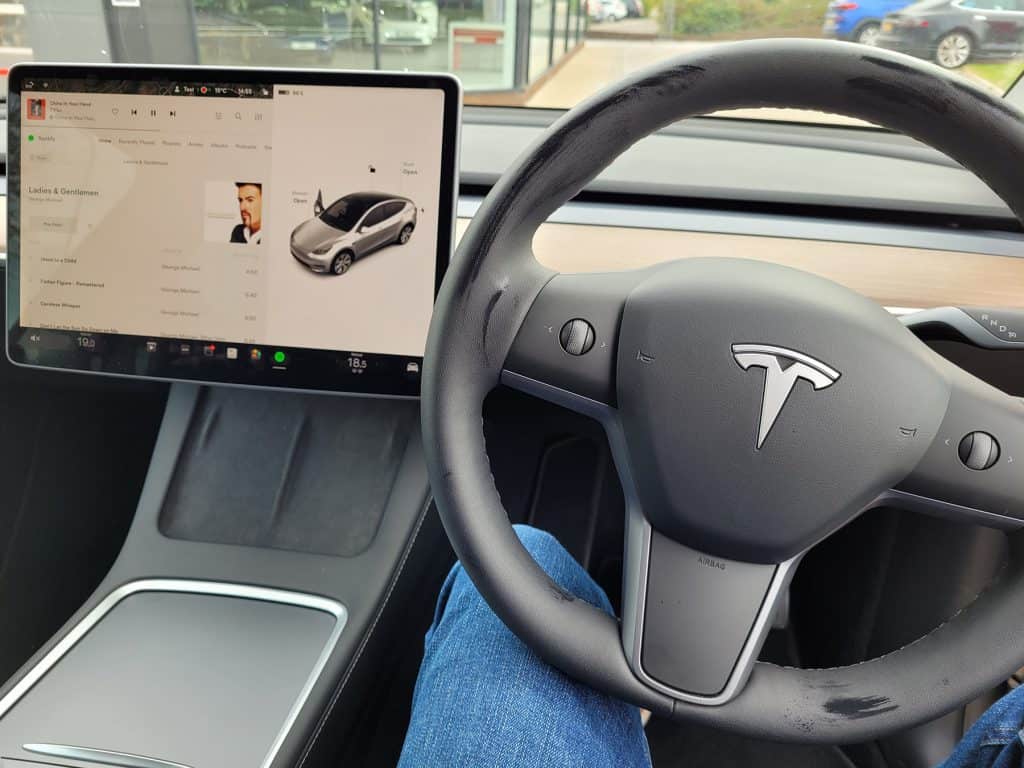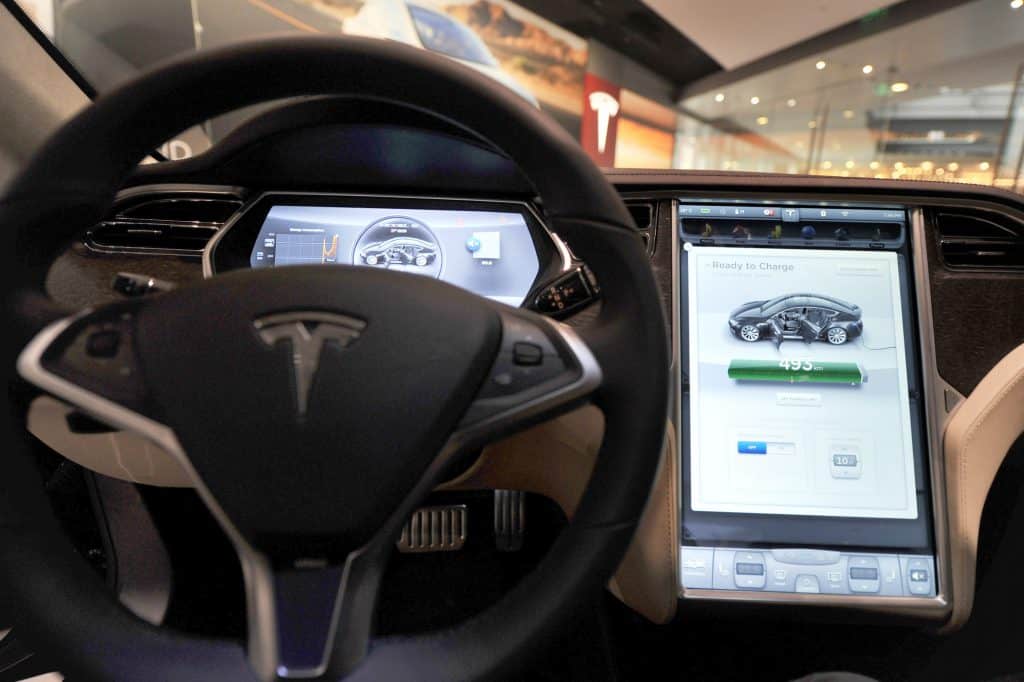What’s one of the most noticeable things about any Tesla model? For a lot of people, it’s the enormous big touchscreen that dominates the landscape of the front seating area. On the Tesla Model 3 and Model Y, you’ll find a 15-inch horizontally mounted touchscreen unit, and on the Model X and Model S cars, you’ll find a 17-inch vertically mounted screen that can now be turned and positioned either toward the driver or front passenger as needed.
But why is it that Tesla is offering such a huge screen? It really helps it stand out among the competition, after all:
- Volkswagen ID.4 – 10 inches
- Nissan Leaf – 8 inches
- BMW i3 – 6.5 inches
- Chevy Bolt – 8 inches
- Audi e-tron – 10.1 inches (though with a second 8-inch display below)
- Hyundai IONIQ Electric – 8 inches
One of the very few screens that can beat any Tesla is the Mustang Mach-E, which has a 15.5-inch vertically mounted screen which rivals the Model 3 and Y, but remains unable to best either the Model X or Model S.
Big Tesla Screen: The Reasons

Let’s take a closer look at some of the reasons that Tesla offers such generous screen proportions where other OEMs appear to be so stingy!
Future-Proofing
People who are familiar with the lofty promises of Elon Musk will know that he is someone singularly dedicated to the idea of creating a commercially viable self-driving car. Despite the way he has named some of his gadgetry over the years — Autopilot, Full Self-Driving Mode, etc. — he has yet to surpass Level 2 of the 6 SAE levels of driving automation scale. He’s getting closer all the time, however, and continues to say that real full self-driving is just around the corner.
What does this have to do with the touchscreens? It’s future-proofing. Musk has made it clear that he will keep these screens this large, this central, and this important because as his cars do become increasingly autonomous, the role of the driver diminishes, and thus the design of the car needs to be ready for that shift.
Let’s say real autonomous cars arrive on Tesla lots tomorrow, systems that don’t require driver attention, or barely any attention. What will the driver do? They’ll watch Netflix with their passengers, right? Or play games? Maybe engage in a little family “Caraoke”? For that, you need a large central screen that everyone can see, and if you have the Model S or Model X, a rear screen too!
Tesla is creating the car of the future, today. Enormous screens ensure that when the big OTA update comes that makes Tesla cars autonomous, there’s a really great focal point of the car to entertain drivers and passengers alike.
Added Entertainment Function
Following on from the previous point, another reason for having the screens so large is because of what they can do compared to most other screens out there. These aren’t just big screens for navigation and changing the environment settings. They are also hubs of entertainment that warrants having a larger screen.
From streaming services, to console-quality gaming and above-mentioned “Caraoke” singing…a big entertainment list needs a big screen to put it all onto.
No Dashboard Display (Model 3 and Model Y)
Neither the Model 3 nor Model Y come with a traditional dashboard-mounted instrument panel/cluster behind the steering wheel (see further below about the Model S and X). The idea is to make the cockpit as distraction-free as possible, but it’s still important for drivers to be able to see critical information relating to their drive: speed, range, navigation, etc:

This is another important reason that Tesla has made their screens quite so large.
A large screen allows more information to be displayed clearly without becoming too busy or crowded. The driver and front passenger can control everything that appears on the screen, but as the main display of the vehicle, it makes sense that it is made larger.
Design Simplicity
A final key reason for making the touchscreens in Tesla vehicles so large is as part of the overall clean, simple and minimalist design, especially in the newer Model Y and Model 3 cars. A larger screen can house all the features and controls that the driver and passengers need, thus removing the need for a cluttered dashboard or center stack.
The Model 3 has its main screen dominating the center of the front seat area, and then the steering wheel of course, which itself only has some basic controls and stalks coming from it to manage gear shifting, activation of Autopilot, and system reboots, etc.
Everything critical to the car is run through the central screen, including all the things controllable from the wheel or stalks. It’s one system to rule them all — clean, elegant, and simple.
Other Screens in Tesla Cars
Besides the big touchscreens, what other important screens might you find in a Tesla car?
Instrument Cluster (Model S and Model X)

The older two models in the Tesla range are also equipped with an arguably more “classic” feature, namely an instrument cluster. Admittedly, it’s a rather fancy digital one free from the old world of dials and needles, but a panel nonetheless. These screens were not installed on the Model 3 or Model Y cars when they emerged, but neither have they been removed from newer Model S or Model X cars.
It’s a curious thing because it has long been held by Tesla and even automotive designers and engineers that the move away from the instrument cluster was positive because it allows the driver to more easily focus on the road. Not everyone agrees, of course, and clearly there’s some division about it at Tesla because precisely half the models in production still have an instrument display while half do not.
Those who are driving Model 3 or Model Y cars are not without options, however. There are many aftermarket options when it comes to installing an instrument panel in either of these cars for those that want one. You can see an example for yourself on YouTube, which I include below too:
Rear Entertainment Screens
Another feature currently only afforded to the higher end Model S and Model X vehicles is the rear entertainment screen.
Neither the Model 3 or Model Y offers this screen, but there is significant evidence to suggest that they will do so perhaps for the 2023 model year. An article on autoevolution.com shows evidence that images of new electrical infrastructure for the Model 3 and Model Y indicate routing for a second entertainment screen.
The rear screen offers backseat passengers a more fun gaming and entertainment experience as they can use remote controls to play games from any seat — handy in the Model X in particular which seats up to 7 people in 3 rows — as well as watch other media and streaming services. They can also use the screen to alter environment controls.
Conclusion: Tesla Remains Streets Ahead in the Screen Game
While there are companies hot on their heels in offering large and high-quality screens in their EVs and even gasoline cars, Tesla still remains far ahead in terms of innovation and capability. The vast majority of screens are still essentially just windows for Apple CarPlay and Android Auto, as well as radio controls, navigation, and such. They can’t offer anything like the range of interesting entertainment and other unique things that Tesla’s screens do.
Furthermore, now that the Model S and Model X have even got their screens swiveling, it’s just yet another way that the Tesla screen is setting the future standard for others to follow. By the time Tesla has moved onto their next screen development, perhaps other OEMs will be just about caught up to where Tesla is now.
Tesla still has challenges with their screens, of course. As big as they are, they still suffer from faults and complications, especially in older models. The screens of the Model 3 were lauded as fast and responsive when that car came out in 2017, but before that they were criticized for being clunky, and even experienced issues like the yellow border which was caused by bad adhesive. Size can’t fix everything, in the end.
1 comment
Ahead on the game? The giant screens are THE reason I’d never buy a Tesla.